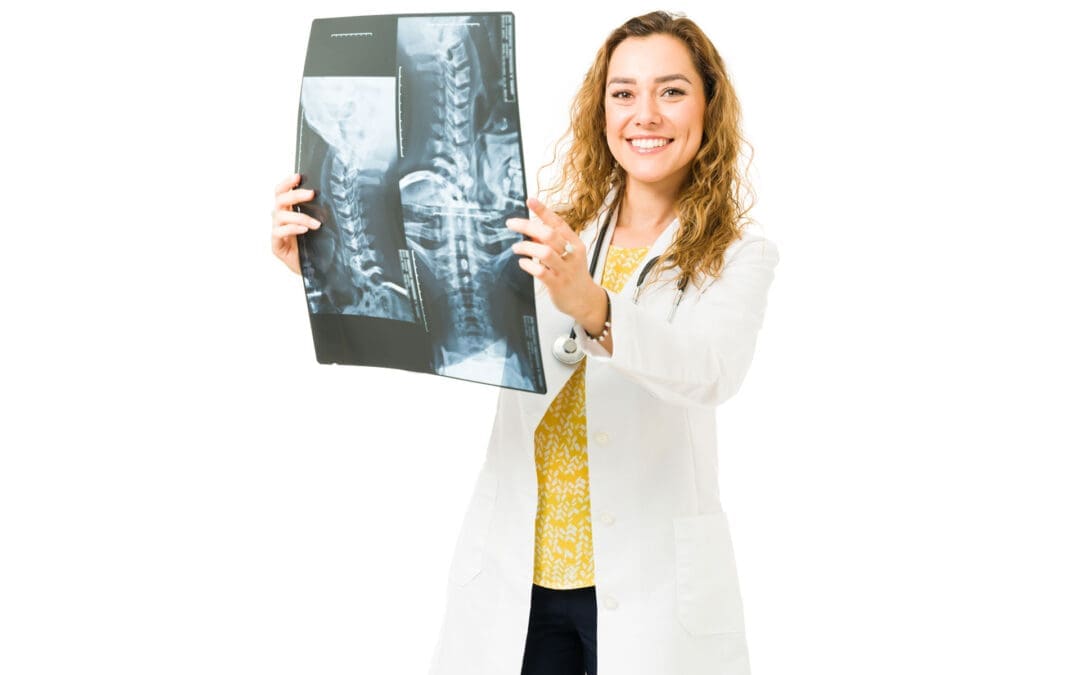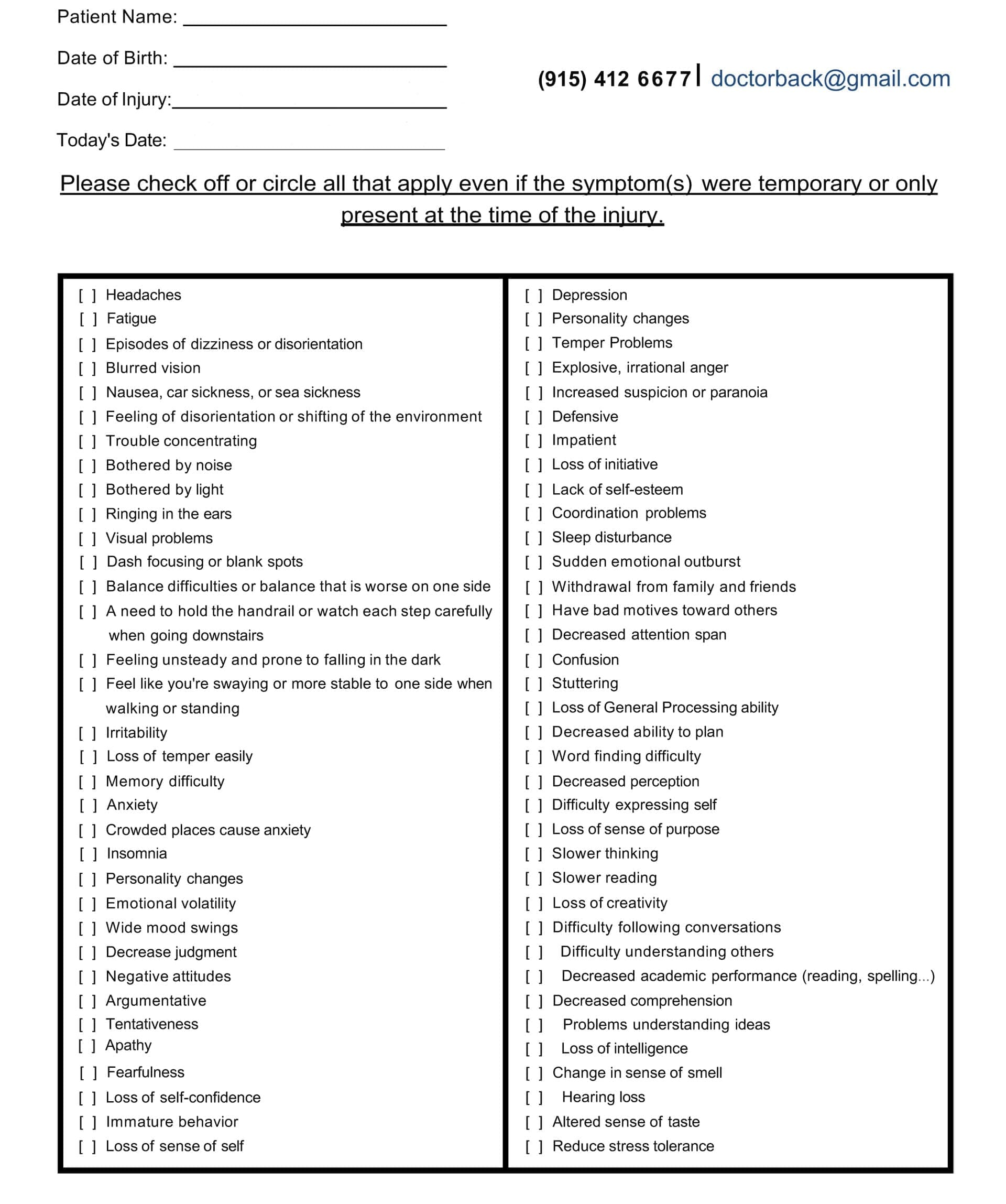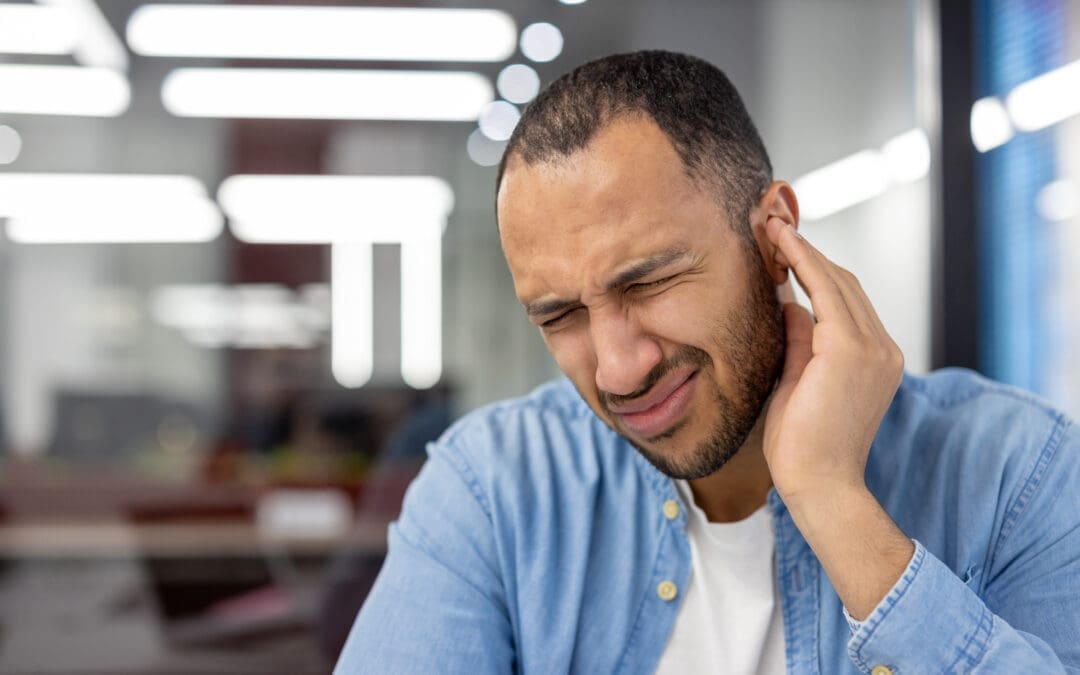
Traumatic Brain Injury: Coping Strategies to Implement to Reduce Stress
Discover the impact of stress on traumatic brain injury. Insights into coping strategies can enhance recovery and well-being.
Understanding Traumatic Brain Injury: How Stress Impacts the Body and Brain, and How Chiropractic Care Can Help
Traumatic brain injury (TBI) represents one of the most complex medical conditions affecting millions of people each year. While many people think of TBI as simply a physical injury to the head, it actually triggers a complicated chain of events throughout the entire body. Understanding how TBI affects both the brain and body, especially in relation to stress, can help individuals seek appropriate treatment and improve their recovery outcomes. This article explores the relationship between TBI and stress, examines how these conditions affect cognitive function and the body’s autonomic nervous system, and discusses how chiropractic care combined with other integrative treatments can support healing and prevent long-term problems. ninds.nih+1
What Is Traumatic Brain Injury?
A traumatic brain injury occurs when an external force causes the brain to function differently than it should. This injury can happen in several ways, including a bump, blow, or jolt to the head, or when an object penetrates the skull and enters the brain tissue. Not all blows or jolts to the head result in a TBI, but when they do, the consequences can range from temporary disruptions in brain function to severe and permanent disability.cdc+1 TBI can be classified into different types based on how the injury occurs. Penetrating TBI, also called open TBI, happens when an object like a bullet or bone fragment pierces the skull and damages brain tissue. Non-penetrating TBI, also known as closed head injury or blunt TBI, occurs when an external force moves the brain within the skull without breaking through the skull itself. This type of injury commonly results from falls, motor vehicle crashes, sports activities, or physical assaults. ncbi.nlm.nih+2
The severity of TBI ranges from mild to severe. Mild TBI, often called a concussion, may cause temporary changes in how the brain works but typically does not show up on standard brain imaging tests. Moderate and severe TBIs involve more significant damage and usually require immediate medical attention. Falls represent the most common cause of TBI, accounting for nearly half of all TBI-related emergency department visits, particularly among children and older adults. Motor vehicle accidents, sports injuries, and assaults also contribute significantly to TBI statistics. biausa+4 Understanding TBI requires recognizing that the injury occurs in two phases. The primary injury happens at the moment of impact, causing immediate damage to brain tissue, blood vessels, and nerve cells. However, a secondary injury phase follows, during which the brain experiences additional damage from processes triggered by the initial trauma. These secondary injury mechanisms include inflammation, oxidative stress, disruption of the blood-brain barrier, and excitotoxicity. This secondary phase can continue for days, weeks, or even months after the initial injury, making prompt and appropriate treatment essential for preventing long-term complications. frontiersin+4
How TBI Affects Brain Function and Causes Cognitive Problems
One of the most challenging aspects of TBI involves the cognitive changes that can occur. Cognitive function refers to how the brain processes information, encompassing abilities such as attention, memory, learning, reasoning, and problem-solving. When someone experiences a TBI, these cognitive abilities often become impaired, creating significant difficulties in daily life. alz+2 Disturbances in attention, memory, and executive functioning represent the most common cognitive consequences of TBI at all severity levels. Executive functions encompass complex thinking skills, including planning, organizing, decision-making, and problem-solving. Many people with TBI find it harder to focus on tasks, take longer to process thoughts, and struggle to remember new information. These cognitive impairments can persist long after the initial injury and significantly impact a person’s ability to return to work, school, or their previous level of functioning. pubmed.ncbi.nlm.nih+3
The cognitive effects of TBI vary depending on which parts of the brain are damaged and the severity of the injury. Research shows that processing speed becomes the most impacted cognitive domain following moderate to severe TBI, with over forty percent of individuals showing impaired speed with or without other cognitive problems. In contrast, individuals with mild TBI exhibit a more even distribution of impairments across various cognitive domains, including processing speed, memory, and executive function. Slow processing speed can persist for years after moderate to severe TBI and has the strongest relationship with functional outcomes. jamanetwork Memory problems after TBI can take different forms. Some individuals struggle to learn and remember new information, a condition called anterograde amnesia. Others may have difficulty recalling events that happened immediately before or after the injury, known as post-traumatic amnesia. These memory difficulties can significantly impact daily functioning, making it hard to remember appointments, follow instructions, or maintain social relationships. headway+4 The mechanisms behind these cognitive impairments involve damage to specific brain structures and disruption of neural networks. TBI can cause diffuse axonal injury, a condition characterized by widespread damage to the brain’s white matter. White matter contains the nerve fibers that allow different brain regions to communicate with each other. When these connections become damaged, the flow of information throughout the brain becomes disrupted, leading to cognitive difficulties. Additionally, TBI can cause focal injuries to specific brain regions that control particular cognitive functions. ninds.nih+1
The Complex Relationship Between TBI and Stress
The relationship between TBI and stress operates in multiple directions, creating a complicated pattern that affects recovery. First, the event causing a TBI often represents a traumatic experience that triggers significant psychological stress. Second, TBI itself creates physiological stress on the body as it attempts to heal from the injury. Third, dealing with the symptoms and consequences of TBI creates ongoing stress that can interfere with recovery. pmc.ncbi.nlm.nih+2 At the physiological level, stress activates the body’s stress response systems, particularly the hypothalamic-pituitary-adrenal (HPA) axis and the locus coeruleus-norepinephrine system. The HPA axis represents a complex set of interactions between three structures: the hypothalamus in the brain, the pituitary gland, and the adrenal glands. When a person experiences stress, the hypothalamus releases corticotropin-releasing hormone (CRH), which signals the pituitary gland to release adrenocorticotropic hormone (ACTH). This hormone then stimulates the adrenal glands to produce cortisol. Cortisol, often referred to as the stress hormone, helps the body respond to stress by increasing blood sugar levels, suppressing the immune system, and providing energy for the fight-or-flight response. pubmed.ncbi.nlm.nih+4
TBI disrupts the normal functioning of the HPA axis, leading to abnormal stress responses. Research shows that approximately one-quarter of all TBI cases result in adrenal insufficiency due to suppressed HPA axis activation. However, many individuals with TBI actually show elevated cortisol levels, particularly in the acute phase after injury. Studies have found that cortisol remains elevated in people with mild TBI for at least one month after injury. This elevation in cortisol can have significant consequences because chronically high cortisol levels can impede physical and psychological recovery through multiple mechanisms, including altered metabolism, increased neuroinflammation, and activation of pathways linked to psychiatric symptoms. pmc.ncbi.nlm.nih+5 The stress response after TBI becomes particularly problematic because individuals with TBI often suffer from poor stress tolerance. They may have impairments in their ability to evaluate stressors appropriately and difficulty initiating and stopping neuroendocrine stress responses. This dysfunction means that even relatively minor stressors can trigger exaggerated stress responses in people recovering from TBI. The combination of altered stress physiology and reduced stress tolerance creates a situation where stress itself becomes a barrier to recovery. powerofpatients+2 Research on animals and humans demonstrates that stress following TBI can worsen outcomes. In animal studies, rats exposed to social stress immediately before mild TBI showed greater anxiety-like behavior and impaired fear extinction compared to animals that experienced either stress or TBI alone. This finding suggests that stress concurrent with TBI produces more severe psychological outcomes than either insult by itself. The combination of stress and TBI also had greater effects on brain chemistry, particularly affecting serotonin systems associated with anxiety and fear learning. frontiersin
How Stress and TBI Interact to Affect Cognitive Function
The interaction between stress and TBI creates a particularly challenging situation for cognitive function. Both stress and TBI independently impair cognitive abilities, but when they occur together, their effects can compound each other. Understanding these interactions helps explain why some people recover well from TBI while others struggle with persistent cognitive difficulties. pmc.ncbi.nlm.nih+2 Stress affects the brain through multiple mechanisms. Chronic or severe stress reduces levels of brain-derived neurotrophic factor (BDNF), a protein essential for brain health and neuroplasticity. BDNF helps the brain form new neural connections and adapt to challenges. When stress decreases BDNF levels, it impairs the brain’s ability to recover from injury. Stress also increases oxidative stress and inflammation in the brain. Oxidative stress occurs when there are too many reactive oxygen species (ROS) relative to the body’s antioxidant defenses. These reactive molecules can damage brain cells and interfere with normal brain function. pmc.ncbi.nlm.nih+3 TBI similarly increases oxidative stress and inflammation in the brain. The initial mechanical injury damages cells and blood vessels, triggering inflammatory responses that are designed to clear away the damaged tissue. However, when inflammation becomes excessive or prolonged, it can cause additional damage to healthy brain tissue. Studies show that systemic low-grade chronic inflammation can persist for up to one year after mild TBI, much longer than previously recognized. This prolonged inflammation contributes to ongoing cognitive difficulties and other symptoms. journals.plos+5
The combination of stress and TBI creates overlapping pathological processes that intensify cognitive impairment. Both conditions disrupt the balance between excitatory and inhibitory neurons in key brain regions, such as the prefrontal cortex, hippocampus, and amygdala. The prefrontal cortex regulates executive functions, including planning, decision-making, and working memory. The hippocampus plays a crucial role in forming new memories and spatial navigation. The amygdala plays a crucial role in processing emotions, particularly fear and anxiety. When these regions become dysfunctional due to the combined effects of stress and TBI, multiple aspects of cognitive and emotional functioning become impaired. mayoclinic+2 Environmental factors also play an important role in how stress and TBI interact to affect cognitive outcomes. Studies show that environmental enrichment—access to stimulating, complex environments with opportunities for physical activity, cognitive challenge, and social interaction—promotes recovery after TBI. Conversely, lack of environmental enrichment may contribute to cognitive decline in the post-acute phase after TBI. This finding suggests that the environment where a person recovers can significantly influence their outcomes. Barriers such as limited access to resources, inadequate social support, transportation difficulties, and challenging home environments can all impede recovery and contribute to worse outcomes. frontiersin+3
Autonomic Dysfunction After TBI
Beyond cognitive problems, TBI frequently causes autonomic dysfunction, which refers to impaired functioning of the autonomic nervous system (ANS). The ANS controls involuntary bodily functions like heart rate, blood pressure, digestion, breathing, and temperature regulation. It consists of two main branches: the sympathetic nervous system, which activates the body’s “fight or flight” response, and the parasympathetic nervous system, which promotes “rest and digest” functions. pmc.ncbi.nlm.nih+4 The central autonomic network—the brain structures that control the ANS—includes the cerebral cortex (particularly the insular and medial prefrontal regions), amygdala, hypothalamus, and brainstem centers. Because TBI can damage any of these structures, it frequently disrupts normal autonomic function. Studies show that autonomic dysfunction occurs commonly after TBI at all severity levels and contributes significantly to the symptoms people experience. neurologyopen.bmj+3
Signs and symptoms of autonomic dysfunction after TBI are broad and can affect multiple body systems. Common symptoms include headaches, dizziness, balance and coordination problems, nausea, vomiting, sensitivity to light and sound, fatigue, and difficulty concentrating. Autonomic dysfunction can also cause cardiovascular symptoms, such as abnormal heart rate and blood pressure changes, orthostatic intolerance (feeling dizzy or faint when standing up), and exercise intolerance. Gastrointestinal symptoms, including bloating, constipation, diarrhea, and nausea, are also common. Other manifestations include abnormal sweating, dry eyes and mouth, changes in skin color, temperature regulation problems, and visual blurring. concussionalliance+2 Research using heart rate variability (HRV) as a measure of autonomic function shows that both sympathetic and parasympathetic dysfunction occur after TBI. Heart rate variability refers to the variation in time between consecutive heartbeats. Healthy individuals exhibit high HRV, indicating a good balance between sympathetic and parasympathetic activity, as well as the ability to adapt to changing demands. After TBI, many people show decreased HRV, suggesting an autonomic imbalance. This imbalance typically involves increased sympathetic activity and decreased parasympathetic activity, resulting in the body remaining stuck in a heightened state of arousal with difficulty returning to a relaxed state. hellonote+4
The presence of autonomic dysfunction correlates with increased morbidity and mortality in moderate and severe TBI. Autonomic imbalance can lead to cardiac complications, including irregular heart rhythms, sudden cardiac events, and increased blood pressure. Studies show that decreased baroreflex sensitivity—a measure of ANS activity—correlates with increased risk of these cardiac complications. Perturbations of the ANS may result in dangerous heart rhythms and sudden cardiac death. jamanetwork+1 Autonomic dysfunction also affects recovery outcomes more broadly. Research shows that patients with autonomic dysfunction after TBI experience longer periods of post-traumatic amnesia, longer hospital stays, and higher overall healthcare costs. The autonomic symptoms themselves negatively impact quality of life and correlate with other symptoms, such as fatigue, pain, and negative perceptions of health status. Understanding and addressing autonomic dysfunction represents an important but often overlooked aspect of TBI care. pmc.ncbi.nlm.nih+2
Stress, Anxiety, and Reduced Stress Tolerance After TBI
Clinical evidence demonstrates that mild TBI increases the risk for anxiety disorders. Studies show that anxiety symptoms and disorders occur frequently in the first year after mild TBI, with rates significantly higher than in the general population. In military populations, research found that forty-four percent of those with mild TBI screened positive for post-traumatic stress disorder (PTSD), compared to only sixteen percent of those with bodily injuries but no TBI. This elevated risk for anxiety and PTSD after TBI creates significant challenges for recovery. apa+4 The relationship between TBI and PTSD illustrates how these conditions can coexist and interact. TBI and PTSD share overlapping symptoms, making diagnosis complicated. Both conditions can cause problems with memory, concentration, sleep, irritability, and emotional regulation. However, the mechanisms differ: PTSD results from psychological trauma and involves fear conditioning and altered fear responses, while TBI involves physical brain damage that disrupts neural circuits. When both conditions occur together—which happens frequently because brain injuries often result from traumatic events—the symptoms can compound each other and create more severe impairment. pmc.ncbi.nlm.nih+3
Interestingly, research shows that mild TBI actually increases the risk for developing PTSD, a finding that contradicts earlier beliefs that TBI protects against PTSD. Multiple large-scale studies demonstrate that individuals who sustain a mild TBI are significantly more likely to develop PTSD compared to those with no TBI. The mechanisms behind this increased risk remain under investigation, but likely involve altered stress reactivity, enhanced fear conditioning, and dysfunction in brain regions that regulate fear and anxiety. ptsd.va+2 Reduced stress tolerance represents another significant problem after TBI. Individuals with TBI often find that situations that would have been manageable before their injury now feel overwhelming. They may experience heightened emotional reactions to minor stressors and struggle to regulate their stress responses. This reduced stress tolerance stems partly from damage to brain regions involved in emotional regulation and stress appraisal, and partly from the ongoing physiological stress created by the injury itself. abct+1
The chronic activation of stress systems takes a toll on the body. Prolonged elevation of cortisol and sustained sympathetic nervous system activation can lead to multiple adverse effects, including suppressed immune function, increased inflammation, disrupted sleep, mood disturbances, cardiovascular problems, and metabolic dysfunction. These effects create a vicious cycle in which stress impairs recovery, leading to more stress, which in turn further impairs recovery. eihmd+6
The Role of Environmental Factors in TBI Recovery
Environmental factors significantly influence recovery outcomes after TBI. These factors include both the physical environment (such as noise levels, lighting, and crowding) and the social environment (including support systems, access to healthcare, socioeconomic status, and cultural factors). pubmed.ncbi.nlm.nih+4 Research consistently demonstrates that environmental enrichment promotes better outcomes after TBI. Animal studies have shown that housing injured animals in enriched environments—with opportunities for physical activity, cognitive stimulation, and social interaction—leads to improved cognitive function, enhanced neuroplasticity, and better structural recovery of the brain compared to animals housed in standard conditions. Human studies similarly find that greater participation in intellectual and social leisure activities associates with better cognitive outcomes and lower rates of decline. frontiersin
Conversely, lack of environmental enrichment may contribute to post-acute cognitive and neural decline after TBI. Studies document that a significant percentage of TBI survivors experience cognitive decline rather than improvement in the months and years following their injury. This decline may result partly from reduced access to stimulating environments after discharge from intensive rehabilitation services. When people return home from rehabilitation facilities, they may find themselves in environments that are less cognitively and physically stimulating than the structured therapy environment. Additionally, cognitive, physical, or emotional impairments from the TBI may prevent individuals from effectively engaging with potentially enriching environments. frontiersin
Specific environmental barriers commonly reported by TBI survivors include transportation difficulties, challenging physical surroundings (such as poor lighting, excessive noise, or crowding), unsupportive government policies, negative attitudes from others, and challenges posed by the natural environment. These barriers affect multiple aspects of community integration, including employment, social participation, and overall life satisfaction. Addressing these environmental barriers represents an important target for improving outcomes after TBI. biausa+2
Overlapping Risk Profiles: TBI and Comorbid Conditions
TBI creates increased risk for numerous comorbid conditions, creating overlapping risk profiles that complicate treatment and recovery. Research shows that TBI of any severity is associated with increased risk for neurological, psychiatric, cardiovascular, and endocrine conditions. pmc.ncbi.nlm.nih+3 In a large cohort study examining long-term health outcomes after TBI, researchers found that individuals with TBI had a dramatically increased risk for multiple neuropsychiatric conditions. For neurological outcomes, TBI increased the risk of stroke by approximately two-fold, seizure disorders by over three-fold, and dementia by over three-fold. Psychiatric outcomes showed similarly striking increases: depression risk increased by over two-fold, anxiety disorders by over two-fold, sleep disorders by two-fold, suicidality by over two-fold, and substance misuse by over two-fold. Cardiovascular conditions, including hypertension, hyperlipidemia, obesity, and coronary artery disease, all showed increased risk after TBI. Even endocrine conditions like hypothyroidism, diabetes, and hormonal dysfunction occurred more frequently in individuals with a history of TBI. pmc.ncbi.nlm.nih
The relationship between TBI and PTSD represents a particularly important example of overlapping risk profiles. These conditions frequently coexist because brain injuries often occur during traumatic events. The coexistence creates diagnostic challenges due to overlapping symptoms like memory problems, concentration difficulties, sleep disturbances, irritability, and mood changes. Both conditions share certain pathophysiological features, including neuroinflammation, excitotoxicity, and oxidative damage. When TBI and PTSD occur together, they create more complex symptom presentations and greater functional impairment than either condition alone. journals.sagepub+6 Depression represents another common comorbidity after TBI, affecting over half of individuals in some studies. The neuroinflammation and neurochemical changes caused by TBI contribute to the development of depression. Additionally, the functional limitations and life changes resulting from TBI create psychological stress that can trigger or worsen depression. frontiersin+3 Understanding these overlapping risk profiles helps clinicians provide more comprehensive care. Rather than treating TBI in isolation, healthcare providers need to screen for and address comorbid conditions. This comprehensive approach improves overall outcomes and quality of life for TBI survivors. frontiersin+1
Chiropractic Care After Accidents and Injuries-Video
How Chiropractic Care Can Help TBI Recovery
Chiropractic care offers a non-invasive approach to supporting recovery after TBI, particularly when combined with other integrative treatments. While chiropractic care cannot reverse the primary brain injury, it can address many secondary issues that contribute to ongoing symptoms and impaired recovery. pinnaclehealthchiro+6 The foundation of chiropractic care for TBI involves spinal adjustments to restore proper alignment and improve nervous system function. The spine houses the spinal cord, which serves as the primary pathway for communication between the brain and the rest of the body. When vertebrae become misaligned due to trauma—which commonly occurs in accidents that also cause TBI—these misalignments can interfere with nerve signals and contribute to symptoms like pain, headaches, dizziness, and tension. calibrationmansfield+5 Chiropractic adjustments help restore proper spinal alignment, which can relieve pressure on nerves and improve the flow of information throughout the nervous system. This improved communication supports the brain’s healing process and can reduce many TBI-related symptoms. Research shows that chiropractic adjustments can improve overall nervous system function, which proves crucial in the recovery process. neurotraumacenters+5
One important mechanism through which chiropractic care supports recovery from TBI involves restoring cerebrospinal fluid (CSF) flow. Cerebrospinal fluid protects and nourishes the brain, removing waste products and delivering nutrients. After TBI, CSF flow can become disrupted, potentially impeding brain healing. Manual chiropractic adjustments and soft tissue therapy help restore normal CSF flow throughout the brain and spinal cord. This restoration of CSF dynamics represents an essential aspect of brain health and recovery. withinchiro+2 Chiropractic care also addresses musculoskeletal issues that commonly accompany TBI. Many people who sustain a TBI also experience whiplash, neck injuries, or other soft tissue damage. These injuries can cause chronic pain, muscle tension, and reduced mobility, all of which interfere with recovery and quality of life. Chiropractic treatments, including spinal manipulation, soft tissue therapy, myofascial release, and trigger point therapy, help address these musculoskeletal problems. By alleviating physical pain and tension, these treatments support overall healing and enhance the person’s ability to engage in other aspects of recovery. pinnaclehealthchiro+3
Another significant benefit of chiropractic care involves its effects on the autonomic nervous system. As discussed earlier, TBI frequently disrupts autonomic function, resulting in issues with stress regulation, sleep, digestion, cardiovascular function, and other involuntary bodily processes. Chiropractic adjustments help restore balance to the autonomic nervous system by promoting parasympathetic activation. The parasympathetic branch of the ANS controls the body’s rest, digest, and healing responses. By enhancing parasympathetic function, chiropractic care helps shift the body out of the chronic fight-or-flight state that often follows TBI and into a state more conducive to healing. txmac+9 Research demonstrates that chiropractic adjustments can reduce levels of cortisol, the primary stress hormone. Studies have shown that patients receiving chiropractic care experience decreased cortisol levels, along with reduced self-reported stress and improved relaxation. By reducing cortisol and promoting autonomic balance, chiropractic care helps address the stress dysregulation that commonly occurs after TBI. northbayspineandrehab+5 Chiropractic care also improves blood flow, which proves essential for brain healing. Adequate blood circulation delivers oxygen and nutrients to injured brain tissue while removing waste products. Spinal adjustments improve blood flow throughout the body, including to the brain. This enhanced circulation supports the metabolic processes required for tissue repair and neuroplasticity. hmlfunctionalcare+3
Several specialized chiropractic techniques have shown particular promise in treating TBI. Chiropractic neurology focuses on enhancing brain and nervous system function through non-invasive methods, utilizing techniques such as spinal adjustments, sensory therapies, and targeted exercises to stimulate neuroplasticity. This approach addresses conditions like TBI by enhancing neural pathways and brain function. Upper cervical chiropractic techniques, which focus on precise adjustments to the upper neck, can be particularly beneficial for TBI patients as they help optimize brainstem function and reduce pressure on critical neural structures. neurochiro+6
Integrative Approaches: Combining Chiropractic Care with Other Treatments
The most effective approach to TBI recovery typically involves combining chiropractic care with other integrative treatments. This multimodal approach addresses the complex and multifaceted nature of TBI, targeting multiple mechanisms of healing simultaneously. pmc.ncbi.nlm.nih+6 Massage therapy represents an important complementary treatment to chiropractic care for TBI. Massage helps reduce muscle tension, improve circulation, decrease pain, and promote relaxation. After TBI, many individuals experience chronic muscle tension, particularly in the neck and shoulders, which can contribute to headaches and other symptoms. Massage therapy addresses this tension through various techniques, including myofascial release, trigger point therapy, and Swedish massage. Research indicates that massage therapy offers effective short-term relief for chronic pain, enhancing both physical function and quality of life. thinkvida+7 Acupuncture offers another valuable complementary therapy for TBI recovery. This traditional Chinese medicine practice involves inserting thin needles at specific points on the body to restore the flow of energy and promote overall well-being and healing. Scientific research has demonstrated that acupuncture produces measurable physiological effects relevant to TBI recovery. Studies show that acupuncture promotes neurological recovery after TBI by activating the BDNF/TrkB signaling pathway. BDNF represents a crucial protein for brain health, supporting neuronal survival, neuroplasticity, and cognitive function. By enhancing BDNF levels, acupuncture supports the brain’s natural healing processes. pmc.ncbi.nlm.nih+5
Research demonstrates that acupuncture improves multiple aspects of neurological function after TBI, including motor function, sensory abilities, cognitive performance, and synaptic plasticity. In animal studies, acupuncture treatment significantly reduced neurological deficit scores, improved motor coordination, enhanced memory and learning, and increased markers of neuroplasticity compared to control groups. When researchers blocked the BDNF pathway using a specific inhibitor, these beneficial effects of acupuncture disappeared, confirming that the BDNF mechanism underlies acupuncture’s therapeutic effects. pmc.ncbi.nlm.nih Acupuncture also helps reduce neuroinflammation and improve blood flow to affected brain regions. It can alleviate specific TBI-related symptoms such as headaches, dizziness, brain fog, sleep disturbances, and mood problems. Many patients report significant symptom relief and improved quality of life with acupuncture treatment. wildcoasthealth+2
Exercise represents another critical component of comprehensive TBI rehabilitation. Physical activity promotes neuroplasticity, improves cognitive function, enhances mood, and supports overall brain health. Aerobic exercise increases blood flow to the brain, stimulates the release of neurotrophic factors like BDNF, and promotes the growth of new neurons and synapses. Studies show that exercise improves cardiorespiratory fitness, cognitive function, balance, gait, and quality of life in TBI survivors. neuropt+5 However, exercise prescription after TBI requires careful consideration. Research indicates that exercise intensity and timing are significant factors. Exercise that exceeds an individual’s tolerance can activate stress responses and potentially impede recovery. Therefore, exercise programs for TBI should be individualized based on symptom tolerance and gradually progressed as recovery advances. The concept of sub-symptom threshold exercise—activity that does not exacerbate symptoms—has shown particular promise for recovery from TBI. neuliferehab+2
Recommended exercise parameters for TBI recovery include low-resistance, rhythmic, dynamic activities such as walking, jogging, cycling, or using an elliptical machine. Exercise intensity should generally range from 60 to 90 percent of the age-predicted maximum heart rate, with sessions lasting 20 to 40 minutes, performed three to four times per week. These parameters can be adjusted based on individual tolerance and recovery status. neuropt+1 Additional complementary therapies that may benefit TBI recovery include nutritional interventions, stress management techniques, sleep optimization, and cognitive rehabilitation. Nutritional supplementation with vitamins, minerals, omega-3 fatty acids, and antioxidants may support brain healing by reducing inflammation, combating oxidative stress, and providing building blocks for neural repair. Stress management techniques such as meditation, mindfulness practices, breathing exercises, and biofeedback can help address the stress dysregulation common after TBI. Addressing sleep disturbances proves crucial since quality sleep supports brain healing and cognitive recovery. dralexjimenez+9
Dr. Alexander Jimenez’s Integrative Approach to TBI and Injury Care in El Paso
Dr. Alexander Jimenez, DC, APRN, FNP-BC, exemplifies the integrative approach to treating TBI and other injuries at his clinic in El Paso, Texas. His unique dual credentials as both a Doctor of Chiropractic and a board-certified Family Practice Nurse Practitioner enable him to provide comprehensive care that addresses both the biomechanical and medical aspects of injury. dralexjimenez+1 Dr. Jimenez’s clinic specializes in treating various injuries from work accidents, sports activities, personal incidents, and motor vehicle accidents. His practice focuses on evidence-based treatment protocols inspired by principles of integrative medicine, emphasizing the natural restoration of health for patients of all ages. The clinic’s areas of practice include wellness and nutrition, chronic pain management, personal injury care, auto accident rehabilitation, work injuries, back and neck pain, migraine headaches, sports injuries, sciatica, complex herniated discs, stress management, and functional medicine treatments. dralexjimenez+1
A key aspect of Dr. Jimenez’s practice involves correlating patient injuries with dual-scope diagnosis, treatment procedures, diagnostic assessments, and advanced neuromusculoskeletal imaging. This comprehensive approach ensures accurate diagnosis and targeted treatment. Dr. Jimenez utilizes sophisticated diagnostic tools to accurately identify the specific nature and extent of injuries, including those related to TBI complications. dralexjimenez+1 For patients with TBI, Dr. Jimenez’s integrative approach combines multiple treatment modalities to address the complex nature of these injuries. His treatment protocols may include chiropractic adjustments to restore spinal alignment and improve nervous system function, functional medicine interventions to address underlying metabolic and inflammatory issues, acupuncture to promote neurological recovery and reduce symptoms, nutritional support to provide the building blocks for healing, and targeted rehabilitation exercises to restore function and prevent long-term complications. dralexjimenez+1
Dr. Jimenez’s clinic also provides comprehensive support for the legal aspects of injury cases. When patients sustain injuries in motor vehicle accidents or other incidents that may involve legal claims, accurate and thorough medical documentation becomes essential. Dr. Jimenez provides detailed reports that link injuries to the accident, document treatment plans and their necessity, and support compensation claims. His documentation is legally admissible, and he can provide expert testimony to explain his findings clearly to judges, juries, and insurance adjusters. zdfirm+3 The medical evidence Dr. Jimenez provides includes establishing causation—linking the injuries directly to the accident through diagnostic tests and clinical observations. For example, he can demonstrate how the forces involved in a collision cause specific injuries like whiplash, herniated discs, or TBI. His reports detail the severity of injuries, their impact on function and quality of life, and the necessity of ongoing care to achieve optimal recovery. dralexjimenez Dr. Jimenez works closely with personal injury attorneys, providing tailored reports that meet insurance and court standards. His dual licensure enhances his credibility as an expert witness, allowing him to explain both chiropractic and medical aspects of injuries comprehensively. He helps patients navigate insurance claims to ensure their treatments receive proper coverage. This collaboration between medical care and legal support helps ensure that injury victims receive fair compensation for their medical expenses, lost wages, pain and suffering, and long-term care needs. dralexjimenez
The integrative medicine approach used at Dr. Jimenez’s clinic addresses the root causes of symptoms rather than simply masking them with medication. For TBI patients, this means investigating and treating the underlying inflammatory processes, oxidative stress, hormonal imbalances, autonomic dysfunction, and other factors that contribute to persistent symptoms. The clinic uses advanced assessments, including functional medicine health evaluations that examine personal history, nutrition, activity patterns, environmental exposures, and psychological factors. This comprehensive evaluation enables the development of truly personalized treatment plans that address each patient’s unique needs and requirements. wellnesscenterfw+3
An Example of A TBI Symptom Questionnaire
Promoting Natural Healing and Preventing Long-Term Problems
One of the most important goals in TBI treatment involves promoting the brain’s natural healing mechanisms while preventing the development of long-term problems. The brain possesses remarkable plasticity—the ability to reorganize, adapt, and form new neural connections. This neuroplasticity underlies recovery after brain injury. psychiatrictimes+4 Neuroplasticity-based rehabilitation strategies aim to maximize the brain’s reorganization potential. These approaches involve intensive, repetitive practice of functional tasks, which drives the formation of new neural circuits. The principle “neurons that fire together wire together” explains how repeated activation of specific neural pathways strengthens those connections. Through consistent practice and appropriate challenges, new pathways can compensate for damaged brain regions. pmc.ncbi.nlm.nih+2
Effective rehabilitation requires a multidisciplinary approach that integrates physical therapy, occupational therapy, cognitive rehabilitation, speech therapy, psychological support, and complementary treatments. Each discipline targets different aspects of function while working toward common goals. The collaboration between healthcare providers ensures comprehensive care that addresses the complex needs of TBI survivors.p mc.ncbi.nlm.nih+4 Early intervention proves crucial for optimizing outcomes. The brain shows heightened plasticity in the early weeks and months after injury, creating a window of opportunity for rehabilitation. However, neuroplasticity continues throughout life, meaning that improvement remains possible even years after injury with appropriate interventions. The key lies in providing continued stimulation, challenge, and support for neural adaptation. ncbi.nlm.nih+3
Preventing long-term problems requires addressing multiple factors. First, controlling inflammation and oxidative stress helps limit secondary brain damage. Strategies to reduce inflammation include maintaining a healthy diet rich in anti-inflammatory foods, managing stress effectively, ensuring adequate sleep, and potentially using targeted supplements or medications under the guidance of a medical professional. frontiersin+8 Second, maintaining cardiovascular health and metabolic function supports brain healing. Regular exercise, proper nutrition, adequate hydration, and effective management of conditions such as hypertension and diabetes all contribute to optimal brain health. kesslerfoundation+2 Third, addressing psychological health proves essential. The high rates of depression, anxiety, and PTSD after TBI necessitate screening and treatment for these conditions. Psychological interventions, including cognitive behavioral therapy, stress management training, mindfulness practices, and, when appropriate, psychiatric medication, can significantly improve outcomes and quality of life. concussionalliance+6 Fourth, promoting environmental enrichment and social support enhances recovery. Encouraging individuals with TBI to engage in cognitively stimulating activities, maintain social connections, pursue hobbies and interests, and stay physically active promotes continued brain adaptation and prevents decline. pubmed.ncbi.nlm.nih+2 Fifth, monitoring for and treating comorbid conditions prevents complications. Given the increased risk for multiple medical and psychiatric conditions after TBI, regular medical follow-up and comprehensive health management become important. wellnesscenterfw+2
Conclusion
Traumatic brain injury represents a complex medical condition that affects not only the brain but the entire body, particularly through its interactions with stress systems and autonomic function. Understanding TBI requires recognizing both the immediate physical damage and the secondary processes that can continue for months or years after injury. The relationship between TBI and stress operates in multiple directions: TBI disrupts stress regulation systems, stress worsens TBI outcomes, and the experience of living with TBI creates ongoing stress. Cognitive impairments affecting attention, memory, processing speed, and executive function represent common consequences of TBI that significantly impact daily functioning. Autonomic dysfunction creates additional symptoms affecting multiple body systems and interferes with stress regulation. Environmental factors, comorbid conditions, and the quality of rehabilitation and support all influence recovery trajectories. Chiropractic care, particularly when combined with other integrative treatments, offers valuable support for TBI recovery. By addressing spinal alignment, improving nervous system function, restoring cerebrospinal fluid flow, reducing stress hormone levels, promoting autonomic balance, and enhancing blood flow, chiropractic care targets multiple mechanisms relevant to healing. Combined with massage therapy, acupuncture, targeted exercise, nutritional support, and other complementary therapies, this integrative approach provides comprehensive treatment that addresses the multifaceted nature of TBI.
Dr. Alexander Jimenez’s practice in El Paso exemplifies this integrative approach, combining his dual expertise as a chiropractor and nurse practitioner to provide evidence-based care for TBI and other injuries. His comprehensive treatment protocols, advanced diagnostic capabilities, and support for the legal aspects of injury cases ensure that patients receive thorough care addressing both their medical needs and practical concerns. The path to recovery from TBI requires patience, comprehensive care, and attention to multiple aspects of health. By addressing physical injuries, supporting natural healing processes, managing stress and autonomic dysfunction, promoting neuroplasticity through targeted rehabilitation, and preventing long-term complications, individuals with TBI can achieve a meaningful recovery and an improved quality of life. While TBI presents significant challenges, the combination of modern medical understanding, integrative treatment approaches, and the brain’s remarkable capacity for adaptation offers hope for healing and a return to well-being.
References
- Alam, M. M., Lee, J., & Lee, S. Y. (2017). Recent progress in the development of THIQ derivatives as neuroprotective agents for the treatment of neurodegenerative diseases. International Journal of Molecular Sciences, 18(8), 1713. https://doi.org/10.3390/ijms18081713
- Alzheimer’s Association. (2016). Traumatic brain injury. https://www.alz.org/dementia/traumatic-brain-injury-head-trauma-symptoms.asp
- American Brain Injury Association. (2023). Traumatic brain injury. https://www.biausa.org/brain-injury
- Association for the Advancement of Automotive Medicine. (2023). Environmental modifications to rehabilitate social behavior deficits after traumatic brain injury. https://www.sciencedirect.com/science/article/pii/environmental_modifications_tbi
- Baguley, I. J., Heriseanu, R. E., Cameron, I. D., Nott, M. T., & Slewa-Younan, S. (2008). A critical review of the pathophysiology of dysautonomia following traumatic brain injury. Neurocritical Care, 8(2), 293-300.
- Barlow, K. M. (2016). Traumatic brain injury. Handbook of Clinical Neurology, 136, 883-906.
- Brain Injury Canada. (2020). Cognitive effects. https://braininjurycanada.ca/cognitive-effects/
- Bryant, R. A., & Harvey, A. G. (1999). Postconcussive symptoms and posttraumatic stress disorder after mild traumatic brain injury. Journal of Nervous and Mental Disease, 187(5), 302-305.
- Centers for Disease Control and Prevention. (2025). Facts about TBI. https://www.cdc.gov/traumaticbraininjury/facts.html
- Chamoun, R., Suki, D., Gopinath, S. P., Goodman, J. C., & Robertson, C. (2010). Role of extracellular glutamate measured by cerebral microdialysis in severe traumatic brain injury. Journal of Neurosurgery, 113(3), 564-570.
- Coronado, V. G., Xu, L., Basavaraju, S. V., McGuire, L. C., Wald, M. M., Faul, M. D., Guzman, B. R., & Hemphill, J. D. (2011). Surveillance for traumatic brain injury-related deaths. Morbidity and Mortality Weekly Report Surveillance Summaries, 60(5), 1-32.
- Department of Social and Health Services, Washington State. (2011). What is a traumatic brain injury? https://www.dshs.wa.gov/altsa/traumatic-brain-injury/what-traumatic-brain-injury
- Elder, G. A., & Cristian, A. (2009). Blast-related mild traumatic brain injury: Mechanisms of injury and impact on clinical care. Mount Sinai Journal of Medicine, 76(2), 111-118.
- Fann, J. R., Burington, B., Leonetti, A., Jaffe, K., Katon, W. J., & Thompson, R. S. (2004). Psychiatric illness following traumatic brain injury in an adult health maintenance organization population. Archives of General Psychiatry, 61(1), 53-61.
- Ghajar, J. (2000). Traumatic brain injury. Lancet, 356(9233), 923-929.
- Guglielmino, C., & Dean, P. J. (2022). The pathophysiological bases of comorbidity: Traumatic brain injury and post-traumatic stress disorder. Frontiers in Neurology, 12, 654210.
- Headway. (2024). Cognitive effects of brain injury. https://www.headway.org.uk/about-brain-injury/individuals/effects-of-brain-injury/cognitive-effects/
- Hoge, C. W., McGurk, D., Thomas, J. L., Cox, A. L., Engel, C. C., & Castro, C. A. (2008). Mild traumatic brain injury in U.S. soldiers returning from Iraq. New England Journal of Medicine, 358(5), 453-463.
- Huang, S., Wu, B., Liu, J., Jiang, Q., Wang, Y., Li, M., Zhang, J., Luo, A., Zhou, Y., & Guan, S. (2017). Recent advances in pathophysiology of traumatic brain injury. Translational Neuroscience and Clinics, 3(1), 7-14.
- Jamshidi, N., & Cohen, M. M. (2017). The clinical efficacy and safety of tulsi in humans: A systematic review of the literature. Evidence-Based Complementary and Alternative Medicine, 2017, 9217567.
- King, C., Robinson, T., Dixon, C. E., Rao, G. R., Larnard, D., & Nemoto, C. E. (2010). Brain temperature profiles during epidural cooling with the ChillerPad in a monkey model of traumatic brain injury. Journal of Neurotrauma, 27(10), 1895-1903.
- Kumar, A., & Loane, D. J. (2012). Neuroinflammation after traumatic brain injury: Opportunities for therapeutic intervention. Brain, Behavior, and Immunity, 26(8), 1191-1201.
- Leddy, J. J., Haider, M. N., Ellis, M., & Willer, B. S. (2018). Exercise is medicine for concussion. Current Sports Medicine Reports, 17(8), 262-270.
- Li, H., Tang, Z., Chu, P., Song, Y., Yang, Y., Sun, B., Niu, Y., Wang, Y., Mao, X., Lin, C., Huang, X., Ma, K., & Bian, J. M. (2014). Neuroprotective effect of phosphocreatine on oxidative stress and mitochondrial dysfunction induced by glutamate in hippocampal HT22 cells. Neurochemical Research, 39(7), 1205-1215.
- Logsdon, A. F., Lucke-Wold, B. P., Turner, R. C., Huber, J. D., Rosen, C. L., & Simpkins, J. W. (2018). Role of microvascular disruption in brain damage from traumatic brain injury. Comprehensive Physiology, 8(3), 1147-1169.
- Maas, A. I., Stocchetti, N., & Bullock, R. (2008). Moderate and severe traumatic brain injury in adults. Lancet Neurology, 7(8), 728-741.
- Mayo Clinic. (2021). Traumatic brain injury. https://www.mayoclinic.org/diseases-conditions/traumatic-brain-injury/symptoms-causes/syc-20378557
- McAllister, T. W. (2011). Neurobiological consequences of traumatic brain injury. Dialogues in Clinical Neuroscience, 13(3), 287-300.
- McKee, A. C., & Daneshvar, D. H. (2015). The neuropathology of traumatic brain injury. Handbook of Clinical Neurology, 127, 45-66.
- Meyer, D. L., Davies, D. R., Barr, J. L., Manzerra, P., & Forster, G. L. (2012). Mild traumatic brain injury in the rat alters neuronal number in the limbic system and increases conditioned fear and anxiety-like behaviors. Experimental Neurology, 235(2), 574-587.
- National Institute of Neurological Disorders and Stroke. (2023). Traumatic brain injury information page. https://www.ninds.nih.gov/traumatic-brain-injury-information-page
- Prins, M., Greco, T., Alexander, D., & Giza, C. C. (2013). The pathophysiology of traumatic brain injury at a glance. Disease Models & Mechanisms, 6(6), 1307-1315.
- Rabinowitz, A. R., & Levin, H. S. (2014). Cognitive sequelae of traumatic brain injury. Psychiatric Clinics of North America, 37(1), 1-11.
- Rao, V. R., & Parkinson, C. (2017). Traumatic brain injury and post-traumatic stress disorder. https://www.ptsd.va.gov/professional/treat/cooccurring/tbi_ptsd.asp
- Riggio, S., & Wong, M. (2009). Neurobehavioral sequelae of traumatic brain injury. Mount Sinai Journal of Medicine, 76(2), 163-172.
- Risdall, J. E., & Menon, D. K. (2011). Traumatic brain injury. Philosophical Transactions of the Royal Society B: Biological Sciences, 366(1562), 241-250.
- Sharp, D. J., Scott, G., & Leech, R. (2014). Network dysfunction after traumatic brain injury. Nature Reviews Neurology, 10(3), 156-166.
- Smith, D. H., Johnson, V. E., & Stewart, W. (2013). Chronic neuropathologies of single and repetitive TBI: Substrates of dementia? Nature Reviews Neurology, 9(4), 211-221.
- Stern, R. A., Riley, D. O., Daneshvar, D. H., Nowinski, C. J., Cantu, R. C., & McKee, A. C. (2011). Long-term consequences of repetitive brain trauma: Chronic traumatic encephalopathy. PM&R, 3(10 Suppl 2), S460-S467.
- Summers, C. R., Ivins, B., & Schwab, K. A. (2009). Traumatic brain injury in the United States: An epidemiologic overview. Mount Sinai Journal of Medicine, 76(2), 105-110.
- Taylor, C. A., Bell, J. M., Breiding, M. J., & Xu, L. (2017). Traumatic brain injury-related emergency department visits, hospitalizations, and deaths. Morbidity and Mortality Weekly Report Surveillance Summaries, 66(9), 1-16.
- Thurman, D. J., Alverson, C., Dunn, K. A., Guerrero, J., & Sniezek, J. E. (1999). Traumatic brain injury in the United States: A public health perspective. Journal of Head Trauma Rehabilitation, 14(6), 602-615.
- Traumatic Brain Injury Center of Excellence. (2018). TBI symptoms, effects, and veteran support. https://health.mil/Military-Health-Topics/Centers-of-Excellence/Traumatic-Brain-Injury-Center-of-Excellence
- U.S. Department of Veterans Affairs. (2022). Traumatic brain injury and PTSD. https://www.ptsd.va.gov/professional/treat/cooccurring/tbi_ptsd.asp
- Van Reekum, R., Cohen, T., & Wong, J. (2000). Can traumatic brain injury cause psychiatric disorders? Journal of Neuropsychiatry and Clinical Neurosciences, 12(3), 316-327.
- Vasterling, J. J., Bryant, R. A., & Keane, T. M. (2012). PTSD and mild traumatic brain injury. Guilford Press.
- Wang, M. L., Yu, M. M., Yang, D. X., Liu, Y. L., Wei, X. E., & Li, W. B. (2018). Neurological symptoms and their associations with inflammatory biomarkers following traumatic brain injury. Frontiers in Neurology, 13, 876490.
- Werner, C., & Engelhard, K. (2007). Pathophysiology of traumatic brain injury. British Journal of Anaesthesia, 99(1), 4-9.
- Xiong, Y., Gu, Q., Peterson, P. L., Muizelaar, J. P., & Lee, C. P. (1997). Mitochondrial dysfunction and calcium perturbation induced by traumatic brain injury. Journal of Neurotrauma, 14(1), 23-34.
- Yuh, E. L., Mukherjee, P., Lingsma, H. F., Yue, J. K., Ferguson, A. R., Gordon, W. A., Valadka, A. B., Schnyer, D. M., Okonkwo, D. O., Maas, A. I., Manley, G. T., & TRACK-TBI Investigators. (2013). Magnetic resonance imaging improves 3-month outcome prediction in mild traumatic brain injury. Annals of Neurology, 73(2), 224-235.


















